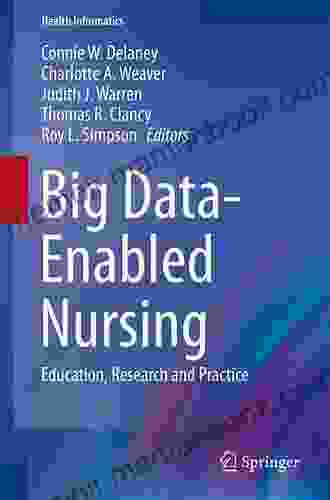Education Research and Practice in Health Informatics: A Comprehensive Guide

4.7 out of 5
| Language | : | English |
| File size | : | 6195 KB |
| Text-to-Speech | : | Enabled |
| Screen Reader | : | Supported |
| Enhanced typesetting | : | Enabled |
| Print length | : | 657 pages |
Health informatics has become increasingly important in healthcare delivery, and the demand for qualified health informatics professionals continues to grow. This has led to a surge in educational programs in health informatics, both at the undergraduate and graduate levels. However, there is a need for more research to inform the development and implementation of these educational programs.
This article provides a comprehensive overview of education research and practice in health informatics. It covers key areas such as assessment and evaluation, curriculum development, pedagogical approaches, and emerging trends. This article serves as a valuable resource for educators, researchers, and students in the field.
Assessment and Evaluation in Health Informatics
Assessment and evaluation are essential components of any educational program. They allow educators to measure student learning and make informed decisions about the effectiveness of their teaching methods. In health informatics, assessment and evaluation can be used to:
- Measure student knowledge and skills.
- Identify areas where students need additional support.
- Evaluate the effectiveness of educational programs.
- Make decisions about curriculum development and revision.
There are a variety of assessment and evaluation methods that can be used in health informatics education. These methods include:
- Written exams.
- Oral exams.
- Projects.
- Portfolios.
- Clinical rotations.
The choice of assessment and evaluation methods should be based on the learning objectives of the course or program. It is also important to consider the time and resources available to educators.
Curriculum Development and Implementation
Curriculum development is the process of creating a plan for teaching and learning. In health informatics, curriculum development should be based on the needs of the students and the healthcare industry. The curriculum should also be aligned with the accreditation standards of the Commission on Accreditation for Health Informatics and Information Management Education (CAHIIM).
When developing a curriculum, it is important to consider the following factors:
- The level of the students (undergraduate or graduate).
- The specific area of health informatics (e.g., clinical informatics, public health informatics, or health information management).
- The learning objectives of the course or program.
- The resources available to educators.
Once a curriculum has been developed, it is important to implement it effectively. This includes developing teaching materials, scheduling classes, and recruiting faculty. It is also important to evaluate the curriculum on a regular basis to ensure that it is meeting the needs of the students and the healthcare industry.
Pedagogical Approaches and Strategies
Pedagogical approaches and strategies are the methods that educators use to teach students. In health informatics, there are a variety of pedagogical approaches that can be used, including:
- Traditional lecture-based instruction.
- Problem-based learning.
- Case-based learning.
- Simulation-based learning.
- Online learning.
The choice of pedagogical approach should be based on the learning objectives of the course or program. It is also important to consider the learning styles of the students.
In addition to pedagogical approaches, there are a variety of strategies that educators can use to improve student learning. These strategies include:
- Active learning.
- Collaborative learning.
- Experiential learning.
- Technology-enhanced learning.
By using effective pedagogical approaches and strategies, educators can create a positive and engaging learning environment for students.
Simulation and Virtual Reality in Healthcare Education
Simulation and virtual reality are increasingly being used in healthcare education. These technologies can provide students with realistic, hands-on experiences that would not be possible in a traditional classroom setting.
Simulation can be used to teach a variety of topics in health informatics, including:
- Patient care.
- Clinical decision-making.
- Health information management.
- Public health informatics.
Virtual reality can be used to create immersive learning experiences that allow students to explore virtual worlds and interact with virtual patients. This technology can be used to teach a variety of topics in health informatics, including:
- Anatomy and physiology.
- Pathology.
- Medical procedures.
- Patient communication.
Simulation and virtual reality are valuable tools for healthcare education. These technologies can provide students with realistic, hands-on experiences that can help them to learn and retain information more effectively.
Emerging Trends and Future Directions
The field of health informatics is constantly evolving. This is due to the rapid pace of technological change and the increasing importance of health information in healthcare delivery. As a result, there are a number of emerging trends and future directions in health informatics education.
Some of these trends include:
- The increasing use of simulation and virtual reality in healthcare education.
- The development of new pedagogical approaches and strategies that are tailored to the needs of health informatics students.
- The growing importance of interdisciplinary education in health informatics.
- The development of new assessment and evaluation methods for health informatics education.
4.7 out of 5
| Language | : | English |
| File size | : | 6195 KB |
| Text-to-Speech | : | Enabled |
| Screen Reader | : | Supported |
| Enhanced typesetting | : | Enabled |
| Print length | : | 657 pages |
Do you want to contribute by writing guest posts on this blog?
Please contact us and send us a resume of previous articles that you have written.
 Top Book
Top Book Novel
Novel Fiction
Fiction Nonfiction
Nonfiction Literature
Literature Paperback
Paperback Hardcover
Hardcover E-book
E-book Audiobook
Audiobook Bestseller
Bestseller Classic
Classic Mystery
Mystery Thriller
Thriller Romance
Romance Fantasy
Fantasy Science Fiction
Science Fiction Biography
Biography Memoir
Memoir Autobiography
Autobiography Poetry
Poetry Drama
Drama Historical Fiction
Historical Fiction Self-help
Self-help Young Adult
Young Adult Childrens Books
Childrens Books Graphic Novel
Graphic Novel Anthology
Anthology Series
Series Encyclopedia
Encyclopedia Reference
Reference Guidebook
Guidebook Textbook
Textbook Workbook
Workbook Journal
Journal Diary
Diary Manuscript
Manuscript Folio
Folio Pulp Fiction
Pulp Fiction Short Stories
Short Stories Fairy Tales
Fairy Tales Fables
Fables Mythology
Mythology Philosophy
Philosophy Religion
Religion Spirituality
Spirituality Essays
Essays Critique
Critique Commentary
Commentary Glossary
Glossary Bibliography
Bibliography Index
Index Table of Contents
Table of Contents Preface
Preface Introduction
Introduction Foreword
Foreword Afterword
Afterword Appendices
Appendices Annotations
Annotations Footnotes
Footnotes Epilogue
Epilogue Prologue
Prologue Oscar Serrallach
Oscar Serrallach Michelle Guido
Michelle Guido Shomari Wills
Shomari Wills Sato Watanabe
Sato Watanabe Jim Davidson
Jim Davidson Mark D Benigni
Mark D Benigni Andrew L Roberts
Andrew L Roberts Randy Sarafan
Randy Sarafan Bruno Rocha
Bruno Rocha Marlyse Goodroad
Marlyse Goodroad Peggy Ashbrook
Peggy Ashbrook Mike Isaac
Mike Isaac Arthur L Costa
Arthur L Costa Janet Lansbury
Janet Lansbury Saver Hippo
Saver Hippo Fiona Leitch
Fiona Leitch George F Walker
George F Walker Tony Gemignani
Tony Gemignani Tiffanie Debartolo
Tiffanie Debartolo Dick Logue
Dick Logue
Light bulbAdvertise smarter! Our strategic ad space ensures maximum exposure. Reserve your spot today!

 Raymond ParkerEngaged Challenge: Kiru Taye Empowers Kenyan Youth Through Technology and...
Raymond ParkerEngaged Challenge: Kiru Taye Empowers Kenyan Youth Through Technology and...
 Miguel de CervantesThe House That Kicked Up Its Hooves On Halloween: The Delmarva Renovators
Miguel de CervantesThe House That Kicked Up Its Hooves On Halloween: The Delmarva Renovators Vladimir NabokovFollow ·6.9k
Vladimir NabokovFollow ·6.9k Hunter MitchellFollow ·18k
Hunter MitchellFollow ·18k Dale MitchellFollow ·10.6k
Dale MitchellFollow ·10.6k Andrew BellFollow ·13k
Andrew BellFollow ·13k Kurt VonnegutFollow ·5.9k
Kurt VonnegutFollow ·5.9k Corey GreenFollow ·11.7k
Corey GreenFollow ·11.7k Eli BlairFollow ·10.8k
Eli BlairFollow ·10.8k Harry CookFollow ·7.1k
Harry CookFollow ·7.1k

 Robert Browning
Robert BrowningGeorge Gershwin's "Love You Porgy" from Porgy and Bess: A...
George Gershwin's "Love You Porgy" is an...

 Gary Reed
Gary ReedFitness Exercise Motivation and Goals: Build Lean Muscle...
Embark on a...

 Terence Nelson
Terence NelsonEat More, Train Less, and Get Lean: The Mr. America...
In today's fast-paced world, achieving a...

 J.D. Salinger
J.D. SalingerThe Mystical Poetry of the Wise Magi: Interpreting the...
In the realm of...

 Blake Bell
Blake BellStep By Step Instructions To Maximize Cryptocurrency...
Cryptocurrency...
4.7 out of 5
| Language | : | English |
| File size | : | 6195 KB |
| Text-to-Speech | : | Enabled |
| Screen Reader | : | Supported |
| Enhanced typesetting | : | Enabled |
| Print length | : | 657 pages |










